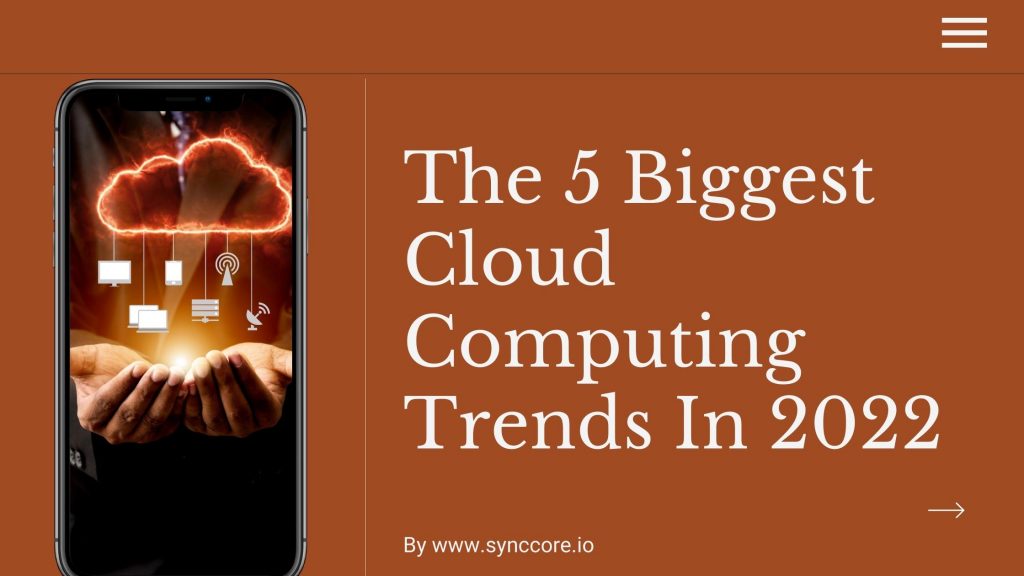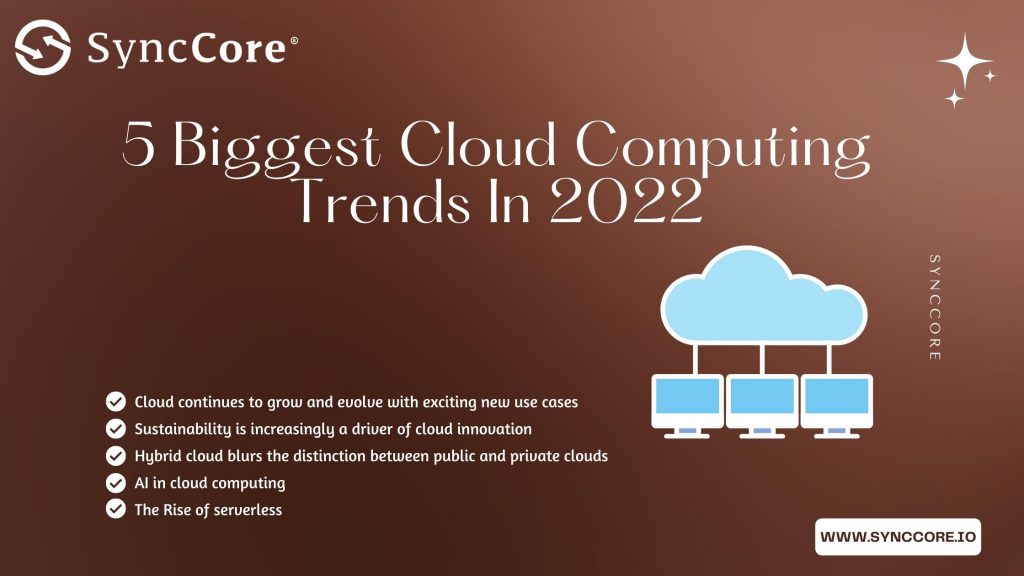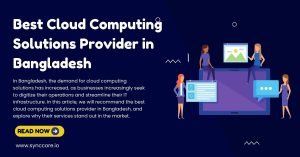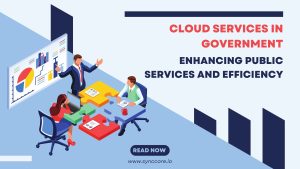Table of Contents
The 5 Biggest Cloud Computing Trends In 2022

Cloud computing exploded in 2020 and 2021 as labor turned virtual and businesses adapted to the worldwide pandemic by focusing on digital service delivery. We will surely witness further rapid acceptance and growth in 2022.
It’s likely that the focus will change away from using cloud tools and platforms to better a single function (such as switching to Zoom meetings) and toward more comprehensive plans centered on enterprise-wide cloud migration.
Enhancing the capabilities of remote and hybridized workforces will be an important trend, but cloud and data center architecture will continue to evolve.
Here’s my take on some of the most important ways this will happen in 2022.

Cloud continues to grow and evolve with exciting new use cases
According to Gartner, global cloud services spending would exceed $482 billion in 2022, up from $313 billion in 2020. From social media and streaming entertainment to connected cars and autonomous internet of things (IoT) infrastructure, cloud computing infrastructure is the backbone of the delivery pipeline for nearly every digital service.
New or forthcoming ultra-fast networks, such as 5G and Wi-Fi 6E, mean that not only more data will be streamed from the cloud, but that new forms of data will be streamed as well. This is evidenced by the increased availability of cloud gaming systems such as Google Stadia and Amazon Luna, which will receive increased investment until 2022.
Cloud virtual and augmented reality (VR/AR) will also be available, resulting in smaller and less expensive headsets. From the customer’s perspective, cloud technology makes all other technologies lighter, faster, and more accessible, and this fact will be a fundamental driver in the migration of additional services to cloud platforms.
Sustainability is increasingly a driver of cloud innovation
Every responsible business recognizes that it has a role to play in addressing climate change’s difficulties. In the tech world, this usually means lowering the energy costs of providing 24/7 “always-on” infrastructure services to customers, as well as reducing the energy usage associated with increasingly powerful computing engines, larger digital storage requirements, and the energy costs of providing 24/7 “always-on” infrastructure services to customers.
The majority of tech behemoths will spend 2022 putting in place tools and innovations to help them meet their net-zero carbon goals. Amazon, the world’s largest cloud firm, is also the world’s largest user of renewable energy, with 206 of its own sustainable energy projects in operation throughout the world, generating around 8.5GW per year. It is now concentrating on reducing the “downstream” energy consumption of its devices, such as Echo and Fire TV, once they have been installed in consumers’ homes. Of course, it’s great that sustainability is high on the agenda these days, but for firms like Amazon, the motivations go beyond altruism — the effects of climate change are expected to cost enterprises up to $1.6 trillion per year by 2025, according to estimates.
Hybrid cloud blurs the distinction between public and private clouds
Businesses have typically had two alternatives when it comes to cloud migration. They can choose public cloud solutions that are easily available and pay-as-you-go, or private cloud options that are more customizable and adaptable. For regulatory and security concerns, a private cloud (where an organization effectively has its own cloud and data never has to leave its premises) is often required.
Today, major cloud providers such as SyncCore, Microsoft, Amazon, and IBM are extending their use of “hybrid” models that combine the best of both worlds. Data that must be accessible quickly and frequently, such as by customers, can be stored on public AWS or Azure servers and accessed via tools, apps, and dashboards.
Data that is more confidential or mission-critical can be stored on private servers with access controlled and processed using proprietary programs. Another factor fueling hybrid cloud’s appeal is that many businesses are moving beyond their initial ventures into cloud computing and are searching for more use cases now that they’ve seen the benefits. As a result, many businesses are now operating in a “multi-cloud” environment, utilizing a variety of services from a variety of vendors. Because of the emphasis on optimizing the user experience and keeping the backend stack invisible when it isn’t needed, a hybrid cloud strategy can lessen the complexity of this.
AI in cloud computing
In terms of the impact on society, cloud computing plays a critical part in the delivery of artificial intelligence (AI) services, which Google CEO Sundar Pichai has described as “more profound than electricity or fire.” For training and processing data, machine learning systems demand a lot of processing power and data bandwidth, which cloud datacenters make available to anybody.
The majority of “every day” AI that we see all around us – from Google Search to Instagram filters – is hosted in the cloud, where machine learning is used to route traffic from data centers to our devices and manage storage capacity. Cloud and AI development and evolution are intrinsically linked, and this will only become more so in 2022 and beyond. “Creative” algorithms – generative machine learning that may create everything from art to synthetic data to train additional AIs – and language modeling – improving the accuracy with which machines can interpret human languages – will be major themes in AI. Cloud computing will undoubtedly play a crucial role in both delivering these services to customers and constructing the infrastructure required to do so.
The Rise of serverless
Serverless cloud is a novel concept that’s gaining acceptance in the industry thanks to Amazon (AWS Lambda), Microsoft (Azure Functions), and IBM Cloud Functions, among others. It’s also known as “functions-as-a-service,” and it refers to the fact that businesses aren’t obligated to lease servers or pay for fixed amounts of storage or bandwidth.
It provides a true pay-as-you-go service in which infrastructure increases discreetly as an application’s needs change. Of course, it’s not truly serverless – the servers remain – but it does create another degree of abstraction between the user and the platform, removing the need for the user to deal with configurations and technicalities. Serverless computing in cloud computing will play a significant role in the broader trend of generating new user experiences that make innovation more accessible throughout the cloud and the entire digital landscape.
Read More:



